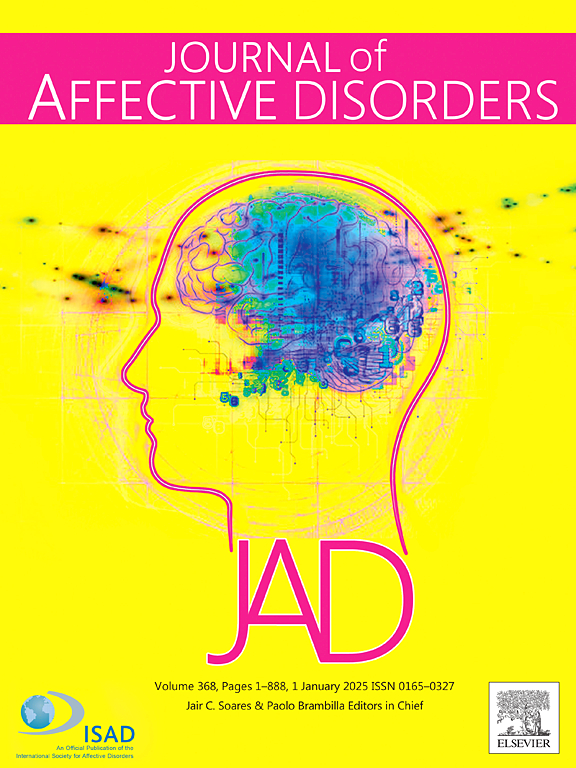使用带有社交线索的人工智能聊天机器人干预抑郁症:一项有效性的随机试验
IF 4.9
2区 医学
Q1 CLINICAL NEUROLOGY
引用次数: 0
摘要
抑郁症在大学生中是一个严重的问题,而聊天机器人是一种流行的干预工具。社交线索被用于聊天机器人的设计中,但它们在抑郁症治疗中的有效性仍有待验证。这项研究旨在比较高社交线索(HSC)和低社交线索(LSC)设计的聊天机器人对抑郁症状的影响。方法采用开放标签随机对照试验,为期16周。84名基线患者健康问卷-9 (PHQ-9)得分≥9的大学生被随机分为HSC组(文本+语音+动画)和LSC组(纯文本)。每4周收集一次临床结果,包括PHQ-9、广泛性焦虑障碍量表(GAD-7)、积极和消极情绪量表(PANAS)评分。次要测量包括用户满意度(客户满意度问卷-8,CSQ-8),治疗联盟(工作联盟清单-短修订,WAI-SR)和自我报告的依从性。结果两组间基线特征无显著差异。意向治疗分析显示,HSC组取得了更大的PHQ-9降低(d = 0.63, P <;GAD-7评分(d = 0.50, P = 0.003)与LSC组比较差异有统计学意义。HSC组也表现出更高的依从率(d = 0.82, P <;0.01), CSQ-8 (P = 0.02),和WAI-SR得分(P & lt;0.001)。LSC组。结论高社交提示设计的聊天机器人在缓解抑郁和焦虑方面显著优于纯文本版本,同时提高了依从性、满意度和治疗联盟性。本文章由计算机程序翻译,如有差异,请以英文原文为准。
Depression intervention using AI chatbots with social cues: a randomized trial of effectiveness
Background
Depression is a serious problem among college students, and chatbots are a popular intervention tool. Social cues are used in chatbot design, but their effectiveness in depression treatment remains to be verified. This study aimed to compare the effects of chatbots with high-social-cue (HSC) versus low-social-cue (LSC) designs on depressive symptoms.
Methods
An open-label randomized controlled trial was conducted over 16 weeks. Eighty-four college students with baseline Patient Health Questionnaire-9 (PHQ-9) scores ≥9 were randomly assigned to either an HSC group (text + voice + animations) or LSC group (text-only). Clinical outcomes, including PHQ-9, Generalized Anxiety Disorder scale (GAD-7), and Positive and Negative Affect Schedule (PANAS) scores, were collected every 4 weeks. Secondary measures included user satisfaction (Client Satisfaction Questionnaire-8, CSQ-8), therapeutic alliance (Working Alliance Inventory-Short Revised, WAI-SR), and self-reported adherence.
Results
Baseline characteristics did not differ significantly between groups. Intention-to-treat analysis revealed that the HSC group achieved greater reductions in PHQ-9 (d = 0.63, P < 0.01) and GAD-7 (d = 0.50, P = 0.003) scores compared to the LSC group. The HSC group also demonstrated higher adherence rates (d = 0.82, P < 0.01), CSQ-8 (P = 0.02), and WAI-SR scores (P < 0.001). LSC group.
Conclusion
Chatbots with high-social-cue designs significantly outperformed text-only versions in alleviating depression and anxiety, while enhancing adherence, satisfaction, and therapeutic alliance.
求助全文
通过发布文献求助,成功后即可免费获取论文全文。
去求助
来源期刊

Journal of affective disorders
医学-精神病学
CiteScore
10.90
自引率
6.10%
发文量
1319
审稿时长
9.3 weeks
期刊介绍:
The Journal of Affective Disorders publishes papers concerned with affective disorders in the widest sense: depression, mania, mood spectrum, emotions and personality, anxiety and stress. It is interdisciplinary and aims to bring together different approaches for a diverse readership. Top quality papers will be accepted dealing with any aspect of affective disorders, including neuroimaging, cognitive neurosciences, genetics, molecular biology, experimental and clinical neurosciences, pharmacology, neuroimmunoendocrinology, intervention and treatment trials.
 求助内容:
求助内容: 应助结果提醒方式:
应助结果提醒方式:


